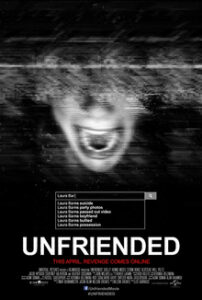Contents

Kermode and Mayo’s sentiment on Unfriended cast (director):
| Actor/ Character | Sentiment |
|---|---|
| Leo Gabriadze, Director | Meh |
| Note: Sentiment analysis performed by Google Natural Language Processing. | |
 |
|
Full-text transcript of the Unfriended movie review:
[00:00:00] Unfriended is this new cyber horror movie, you almost certainly see the adverts has been quite a lot of news articles written about it. The story essentially is a group of young friends are having a having an online Skype chat and messaging each other. And whilst they’re doing all this, a faceless troll who appears to be channeling the spirit of a fellow student who died a year ago turns up in their within their chat. And whatever they do, they can’t get rid of the troll. And the sort of the sucker punch of the movie is that the whole thing plays out on the computer screen of one of the protagonists. So as you’re watching it, what you’re watching is the computer screen, which has got these pop up windows, which is video chats, which is all messages, which is the Spotify stuff, which is links to YouTube, which is Google searches. So essentially for the duration of the movie, you are watching the thing play out on a computer screen.
[00:00:56] Hey, twenty five hour. Ten, ten, twenty, ten. Ten, thirty five. Now it’s time check, so fifty to fifty, fifty to fifty, fifty, fifty, fifty, no, it’s it’s a mental value to have seizures also shoot. Are you sure? Yes. She told me like a long time ago she had the sickness that causes seizures. Maybe she just had a seizure. Seeing her have a seizure, I don’t know. I mean, anybody ever see her having a seizure now? I feel bad. No, no. Did you. They said ten fifty to fifty five. Fifty five. Wait, stress does cause seizures. OK. Yeah. OK, well I feel bad. I should tell you right now it’s a corner case. OK. OK. What else. Ten. Forty five. Well, I got hey,
[00:02:13] So what’s going on in that is that they’re all seeing vowel, something has happened to vowel, and during the course of the movie, it becomes evident that they are being effectively sort of cyber stalked. And so in many ways, it’s you know, it’s the old horror trope. It’s the Halloween Bloody Valentine. You know, I know what you did. It’s the anniversary death thing. Something happened, the secret in the past, and now it’s coming back to it. But because it’s all played out on a computer screen, this instant is not not something that’s completely original. I mean, if you look, for example, I mean, the idea of computers as being sort of demonic and if it goes back to demon seed and to, you know, evil speak, which is the famous video, Nasty, and then you got hit in a chat room which failed in any way to get a handle on what online interaction looks like in this case. This is a film which actually understands its scope in culture. And so during the course of the movie, you’ve each of them is being cyber stalked with revelations coming out online, which are causing the protagonists to turn against each other. And as I said, the central gimmick is that it plays out on the computer screen. So whilst you’re watching it, you’re seeing windows within windows, your following text messages you’re seeing. And I think your response to it will be to some extent conditioned by how you feel about that culture if you are an older member of the audience.
[00:03:29] One of the things that happened is you can start to feel panicky about, firstly, how much there is to keep up with, you know, where to look, where to, you know, and also the sense of actually these teens being completely dextrous with this. It’s like they’re not even thinking about the way in which it’s working. What makes the film work, however, is that if you are at home with the culture and if you are at home with the you know, with with the the online interaction, what it does is says something quite interesting about cyberbullying, because many people have seen try to say, OK, you’re being stalked through the Internet, well, just log off. And the smart thing about the plot is that at several points they all tell log off, just turn the computer off, walk away. But the point is, they can’t. Why can’t they? Because they’re addicted. Because they’re addicted to the thing. And I think what’s interesting about it is that quite apart from being a horror movie, which has the strength of its formal convictions. So if you think, for example, of The Blair Witch Project, like The Blair Witch Project was a film which said, OK, this is going to play out as the found footage of these people who went out to make a documentary in, you know, Burkittsville Wood.
[00:04:33] And we’re going to say that that’s all there is. There isn’t exterior. That’s what there is. And at the beginning of Blair Witch, you think this is going to drive me mad? I mean, this is a long time. And this is kind of the lodestone of the found footage genre. Obviously, it owes a debt to a retired artist, cannibal holocaust. Obviously, that’s in the background. Yeah, obviously. I know you were going to say I don’t want to preempt you before that, before you brought that up. What about Cannibal Holocaust? I was going. Yeah, exactly. And that’s why I just leapt right in there. So but Blair Witch Project had the strength of its convictions. And despite the fact that the shrieking teenagers seen all the way through their not teenager, there’s a young film students in all the way through on these shaky handheld cameras. So this is going to drive me mad. Actually, what it did was it made the thing believable. It made it credible. I know people who saw Blair Witch when it first came out who genuinely thought, is this real? Is this is this actually real? Well, in the case of in the case of unfriended, which at one point was called cyber natural, what it has is the strength of its conviction. So although a movie like Open Windows last year might have sort of looked at doing this, if this is a complete sort of hermetically sealed world in which actually the irony of it is that whilst they’re all online trying to figure out, you know, is one of them playing the trick on the other one, who is, you know, who’s actually behind all this these Facebook messages that they’re getting from somebody who appears to be the who’s hacked into that account and they all start distrusting each other.
[00:05:49] And in fact, what the movie is doing is it’s saying you’re looking you’re looking the bogeyman straight in the face and the bogeyman is the screen itself. And in many ways, it’s, you know, a freaky teen terrorized slasher movie. But actually below that, it’s a film which is about the fact that cyber bullying only works if you partake in it, if you cooperate with it, if you give it an all the way through the film, there’s links that come up between don’t click that link, don’t do this, don’t do that. And they do. And why do they? Because actually the underlying theme of it is that it’s to do with the fact that you can’t turn the screen off. I went into it feeling a little bit cynical about, you know, how well or how thoroughly this this this idea of playing the thing out on a computer screen work. And I have to say, I was rather impressed by it.
[00:06:36] I mean, the guiding light behind all this is Tima Buchmann Batoff. It was kind of a producer who first had the idea and then got in there and go out, see who’s the director and Nelson Greaves with the screenwriter. And it’s brilliantly edited. That’s the other thing to say. It all looks like it’s done in real time. It looks like actually the actors are all scoping their performances. I mean, they’re they’re not the actors are separated in different rooms and they go they have GoPro cameras that are filming them. So they are talking to each other through cyber links, although not through, you know, through Internet. But and then afterwards, that footage then edited very heavily and all credit to the to the editors who’ve done a really terrific job of editing this stuff into something which is oddly gripping. Also, a lot of the screenwriting was done in post because it’s to do with my messages being written after the fact. I was surprised by how well it worked. I some people will find it unbelievably annoying. Some people will just will just do that thing. I just turn the computers off. But that’s the strength of it. The strength of it is it’s not playing to that audience. It’s playing to the audience that understand you can’t you have to look, you have to be part of it. You can’t unplug. And that is what makes it work.
Be the first to leave a review.
